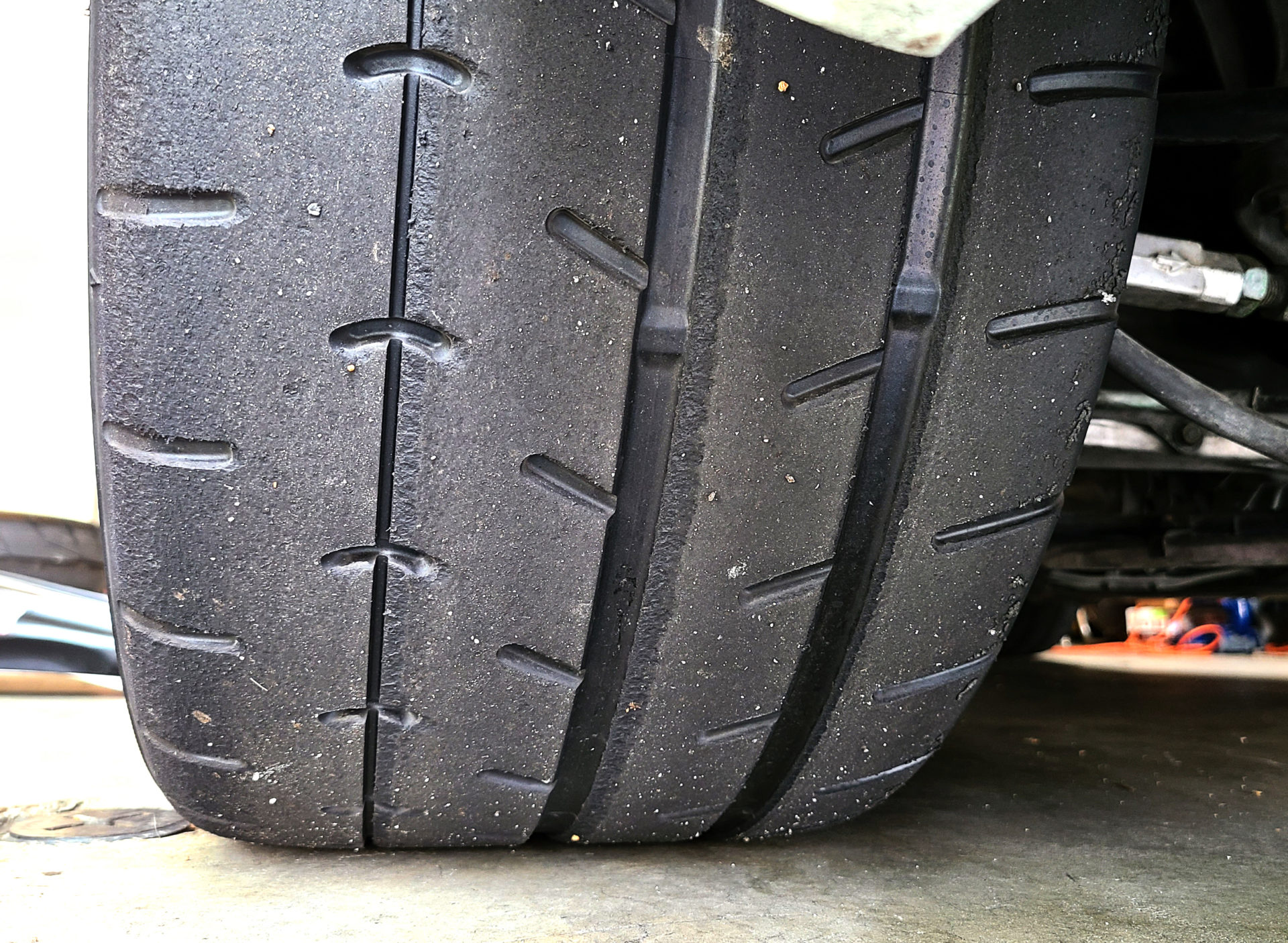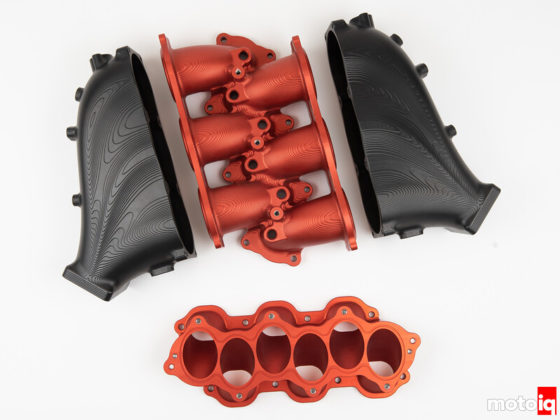 We reinstalled the damper back onto the car and set our ride height.
We reinstalled the damper back onto the car and set our ride height.
 We got the front 215/40-17 front Yokohama A052 tires mounted to our 17×8 Volk CE28 wheels.
We got the front 215/40-17 front Yokohama A052 tires mounted to our 17×8 Volk CE28 wheels.

The rear 265/35-18 Yokohama A052s were mounted on the 18×9.5 CE28s, and the car was ready to hit the track.
 We headed to Buttonwillow on an early morning and were excited to see what kind of lap times we could turn. The ride quality of these super-sticky track-focused tires was very impressive. There was very little tire noise and the tires soaked up uneven pavement without much NVH transferred into the car. I was quite impressed with the road manners of these tires. You could daily drive them without driving yourself crazy from drone like many loud and harsh-riding track-focused tires can be.
We headed to Buttonwillow on an early morning and were excited to see what kind of lap times we could turn. The ride quality of these super-sticky track-focused tires was very impressive. There was very little tire noise and the tires soaked up uneven pavement without much NVH transferred into the car. I was quite impressed with the road manners of these tires. You could daily drive them without driving yourself crazy from drone like many loud and harsh-riding track-focused tires can be.
The ride quality from a spring standpoint is hard to pick apart, but the fact that the ride did not feel stiffer or harsher with a 30n/mm stiffer spring does further lend credibility that running stiffer Swift springs might not actually hurt ride quality much at all, and potentially can improve it if you use the same rates.
 On track, the A052s simply amaze. The amount of grip is astonishing for a ‘street’ tire. The feedback and communication were great with audible queues of the limit and a lot of feel from the seat of the pants. The break-away characteristics of the tire are quite progressive and friendly, without ‘snapping’ into oversteer like many high-grip tires tend to do.
On track, the A052s simply amaze. The amount of grip is astonishing for a ‘street’ tire. The feedback and communication were great with audible queues of the limit and a lot of feel from the seat of the pants. The break-away characteristics of the tire are quite progressive and friendly, without ‘snapping’ into oversteer like many high-grip tires tend to do.




18 comments
That NSX looks fantastic. Why did you go back to the restrictive stock intake manifold and muffler?
A052’s will be my top choice for when go for new tires for my track NC, thanks to your review.
The car looks so right with 17s and 18s vs the larger wheel set. You mention the roll center debacle, but I can’t imagine there’s not correction kits made for the NSX. Have you looked into them?
Like James asked above, why go back to stock exhaust setup? Was the previous setup just too loud?
I’ll be track testing 17/18 vs 18/19 soon.
There are not any roll center correction options out there. Which is why I’ll be developing a billet upright to fix this in addition to the dry sump I designed that retains air conditioning.
The stock muffler was to make the car tolerable until the turbo goes on since the previous exhaust was pretty much straight-piped. The stock manifold was due to the gutted and ported one being modified for a drive by wire throttle which will go on soon.
How disruptive to the drivability of the car would it be to simply make both the front and rear rims sizes 18″? I know the NSX has always been designed with staggered sizes and widths of tires. Would it even be possible to standardize them?
As long as the outer diameters are within the tolerance of the ABS, 18/18 is fine and has been done a lot.
is the vid on page 6 working for everyone else? I get an error (Playback ID: zVTOmS3S9fZHDntm) when I click on it…
Is it working now?
yes, thanks!
Can you explain/educate on your driving style a little please? Going into turn 1 you say “a little bit of entry neutrality” and from what I can observe you did that by turning in sharply and then quickly reducing steering angle. Is to counter the understeer you would have gotten if you turned in more smoothly? And what were you doing with you feet when you did the sharp turn in?
Thanks
started watching your Senna vid, you said the same thing about entry neutrality for turn 1 but didn’t do the sharp turn in then dial back. Can you explain what you mean by “entry neutrality” too? I mean the words are kinda self explanatory, but I’m hoping I can learn something I didn’t think of…
Hi Bob. “neutrality” is when there is little to no steering input as the car is cornering, before the point where the car oversteers and requires counter-steer (steering in the opposite direction of the turn).
To answer your question about what I’m doing with my feet: Half of steering a car through a corner is done with the steering wheel. The other half of steering a car is with your feet – weight transfer from the application of throttle and brake. The NSX has a slower steering rack and the suspension geometry causes the car to turn more as the car is trail-braking. This causes excess rotation, which is why the car rotates and requires less steering after turn-in (“neutrality”). The Senna on the other hand, uses electronics to apply more braking force to the inside rear tire to help turn the car. This sophisticated system, combined with a quicker steering ratio, does not need as an aggressive steering input for turn-in. But as the system works, the car rotates more than the steering input and also gets ‘neutral’, requiring very little steering INTO the corner. However on exit, when the car understeers, you’ll see more steering input.
thanks for going into detail!
love the explanation
Why not get longer springs and ditch the tender springs while you were replacing them?
Longer springs will lower the spring perch height and will interfere with clearance to the tire.
The rear corner weights of the car are ~900lbs. A ~450lb spring will compress 2″ at ride height. Since there is more than 2″ of droop travel in these dampers, longer springs will still become loose and flop around at full droop travel, which is what helper springs prevent by keeping load on the springs at all times. In short, longer springs won’t solve anything and will cause more problems.
Not sure why it’s so hard to weigh stuff before you change it. When you spend money on a part, it’s kinda nice to know that you are getting some kind of improvement.
Call me an engineer, but I always weigh components, and usually break out the calipers to get specs. It’s actually really fun to geek out on this stuff.
Having said that, I really appreciate the write up.
If you read Part 4 where we cover the CE28’s, they are 17×8” +38 front and 18×9.5” +40 rear CE28s to weigh in at 15lbs and 17lbs respectively.
A052 tires in 215/40-17 front and 265/35-18 rear come in at 19 & 24lbs respectively.
Hey Billy, thanks for this! Question. How much front camber were you running